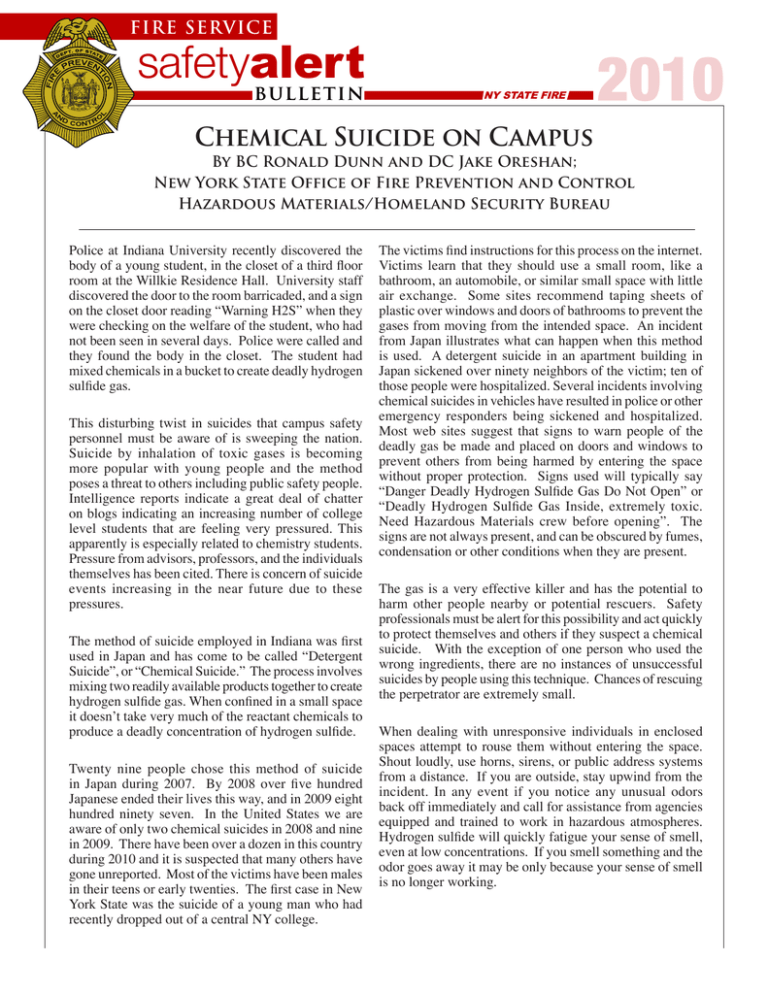2010 alert Chemical Suicide on Campus
advertisement

FIRE SERVICE safetyalert bulletin NY STATE FIRE 2010 Chemical Suicide on Campus By BC Ronald Dunn and DC Jake Oreshan; New York State Office of Fire Prevention and Control Hazardous Materials/Homeland Security Bureau Police at Indiana University recently discovered the body of a young student, in the closet of a third floor room at the Willkie Residence Hall. University staff discovered the door to the room barricaded, and a sign on the closet door reading “Warning H2S” when they were checking on the welfare of the student, who had not been seen in several days. Police were called and they found the body in the closet. The student had mixed chemicals in a bucket to create deadly hydrogen sulfide gas. This disturbing twist in suicides that campus safety personnel must be aware of is sweeping the nation. Suicide by inhalation of toxic gases is becoming more popular with young people and the method poses a threat to others including public safety people. Intelligence reports indicate a great deal of chatter on blogs indicating an increasing number of college level students that are feeling very pressured. This apparently is especially related to chemistry students. Pressure from advisors, professors, and the individuals themselves has been cited. There is concern of suicide events increasing in the near future due to these pressures. The method of suicide employed in Indiana was first used in Japan and has come to be called “Detergent Suicide”, or “Chemical Suicide.” The process involves mixing two readily available products together to create hydrogen sulfide gas. When confined in a small space it doesn’t take very much of the reactant chemicals to produce a deadly concentration of hydrogen sulfide. Twenty nine people chose this method of suicide in Japan during 2007. By 2008 over five hundred Japanese ended their lives this way, and in 2009 eight hundred ninety seven. In the United States we are aware of only two chemical suicides in 2008 and nine in 2009. There have been over a dozen in this country during 2010 and it is suspected that many others have gone unreported. Most of the victims have been males in their teens or early twenties. The first case in New York State was the suicide of a young man who had recently dropped out of a central NY college. The victims find instructions for this process on the internet. Victims learn that they should use a small room, like a bathroom, an automobile, or similar small space with little air exchange. Some sites recommend taping sheets of plastic over windows and doors of bathrooms to prevent the gases from moving from the intended space. An incident from Japan illustrates what can happen when this method is used. A detergent suicide in an apartment building in Japan sickened over ninety neighbors of the victim; ten of those people were hospitalized. Several incidents involving chemical suicides in vehicles have resulted in police or other emergency responders being sickened and hospitalized. Most web sites suggest that signs to warn people of the deadly gas be made and placed on doors and windows to prevent others from being harmed by entering the space without proper protection. Signs used will typically say “Danger Deadly Hydrogen Sulfide Gas Do Not Open” or “Deadly Hydrogen Sulfide Gas Inside, extremely toxic. Need Hazardous Materials crew before opening”. The signs are not always present, and can be obscured by fumes, condensation or other conditions when they are present. The gas is a very effective killer and has the potential to harm other people nearby or potential rescuers. Safety professionals must be alert for this possibility and act quickly to protect themselves and others if they suspect a chemical suicide. With the exception of one person who used the wrong ingredients, there are no instances of unsuccessful suicides by people using this technique. Chances of rescuing the perpetrator are extremely small. When dealing with unresponsive individuals in enclosed spaces attempt to rouse them without entering the space. Shout loudly, use horns, sirens, or public address systems from a distance. If you are outside, stay upwind from the incident. In any event if you notice any unusual odors back off immediately and call for assistance from agencies equipped and trained to work in hazardous atmospheres. Hydrogen sulfide will quickly fatigue your sense of smell, even at low concentrations. If you smell something and the odor goes away it may be only because your sense of smell is no longer working. To protect other individuals, move them out of harms way. An initial isolation zone of 100 feet should be established around vehicles. No unprotected people should be allowed within the isolation zone. In apartments or dormitories adjacent living spaces, including floors above, and below, should be evacuated quickly and air handling systems should be shut down. Interview other people in the building to determine if they have noticed any unusual odors. Evacuate further if conditions warrant. Depending on the construction of the building and other circumstances it may be advisable to evacuate the entire building until a thorough investigation proves it to be safe to occupy. The concentration of hydrogen sulfide created will vary with the reactants involved, the quantity used, and the ability of fresh air to enter the space. There is no data to indicate a typical concentration that might be encountered. Suffice it to say that everyone who has mixed the correct chemicals has been found dead. Do not take any unusual risks, protect yourself and others. Hydrogen sulfide is considered Immediately Dangerous to Life and Health (IDLH) at concentrations of 100 parts per million (PPM) or higher. The National Institute of Safety and Health (NIOSH) recommends that workplace exposures to hydrogen sulfide not exceed 10 PPM at any time. Hydrogen sulfide is also flammable at concentrations in air between 4 and 44 percent. It is not believed that flammable concentrations will be encountered in these situations, but it is wise to use meters to detect the gas and measure the concentration. For additional information contact Chief Dunn at Ronald. dunn@dos.state.ny.us or Deputy Chief Oreshan at Jake. oreshan@dos.state.ny.us 518-474-6746. It’s imperative that campus staff and safety personnel be aware of the threat to their personal safety posed by this type of suicide. Agencies with the proper protective equipment and training should be summoned to assist with these events. NYS Department of State phone 518.474.6746 fax 518.474.3240 email fire@dos.state.ny.us www.dos.state.ny.us/fire






